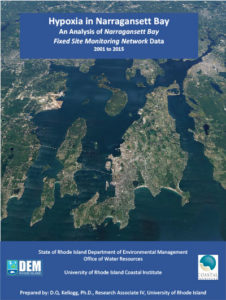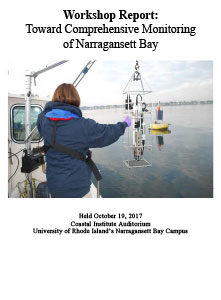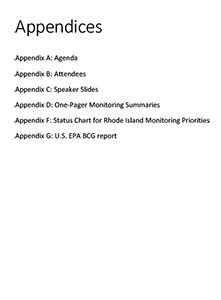
Rhode Island’s environmental monitoring programs represent the best efforts of state and federal agencies and other organizations to collect reliable data on an on-going basis to fulfill the state’s mandates, but there are still monitoring “gaps” and capacity constraints in current programs. These gaps are due to a combination of inadequate funding and complexity of effective environmental monitoring. The RIEMC is committed to identifying critical gaps, working with partners to close them, and tracking progress toward a more comprehensive environmental monitoring program.
Toxic Contaminants in Freshwater Fish: Mercury
Mercury is a metal that is found naturally in the environment, and is also results from the combustion of coal. Mercury can get into freshwater ponds, rivers, and lakes through discharges and air deposition Fish become contaminated through the bioaccumulation of mercury in their tissues. Health agencies advise against a pregnant or breast-feeding woman eating mercury-contaminated fish as it represents a risk of harm to the unborn infant.
The RI Department of Health and Division of Fish and Wildlife, and the Environmental Protection Agency’s Atlantic Ecology Division sample a subset of freshwater bodies around the state to understand the presence of mercury in aquatic ecosystems and to determine if mercury levels are above the safe level. When appropriate, the RI Department of Health uses this data to issue public health advisories concerning fish consumption.
This monitoring is critical to protect human health, but it is not currently being done in a comprehensive manner as it does not have annual base support, and there is no funding for related public health advisories and development of health recommendations.
Harmful Algal Blooms and Cyanobacteria in Freshwaters
Another area where expanded monitoring is needed is harmful algal blooms and cyanobacteria. Cyanobacteria are naturally occurring microorganisms. When certain types of cyanobacteria bloom—a period of extremely high growth—they release toxins at levels that are known to be harmful, and when people or animals, including pets, come in contact with them, the cyanobacteria toxins can cause rashes, stomach or liver illness, respiratory problems, or neurological effects. While we do not know exactly when and why these blooms occur, there is support for them being driven by wind and water currents, sunlight, and nutrient pollution from fertilizers and other sources.
RI Department of Environmental Management and the RI Department of Health have collaboratively maintained a limited monitoring program in which samples of suspected cyanobacteria in freshwaters are confirmed, toxicity levels assessed, and public health advisories issued to warn people to avoid contact with the affected waters. In 2018, RI Department of Environmental Management will be carry out monitoring for cyanobacteria with support of a one-time Environmental Protection Agency grant. Currently, there is no designated funding to sustain this program. Even with this limited level of monitoring, health advisories for cyanobacteria blooms have been issued for over 20 water bodies during the last several years; thus, it is a high priority to secure stable funding for this important public health surveillance effort.
Water Quality Monitoring: Rotational Gaps and Access

Water quality monitoring faces significant challenges, including effective storage of and efficient access to water quality data. Ensuring information systems are able to store, manage and share data has proven challenging for monitoring programs both within and outside of government. Improvements to such systems are needed to facilitate the timely use of data.
As an example, the University of Rhode Island’s volunteer-based Watershed Watch program collects a portion of data that the RI Department of Environmental Management reports to the Environmental Protection Agency. Until recently, these water quality data were stored in individual, static Excel spreadsheets, which was not an efficient process to support state reporting mandates. To modernize this data management process, the Watershed Watch received a $100,000 grant from URI’s Coastal Institute to develop a comprehensive database to improve management, integration, interpretation, and sharing of data and to provide timely water quality information to members of the public and professionals alike; however, the current systems fall short of providing easy public access to data as there is no remote access to the data and the systems need upgrading to interface with federal databases.




